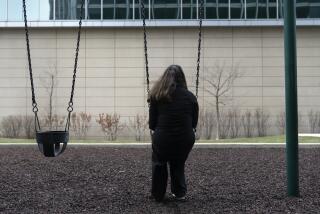LINK BETWEEN TV MOVIES, YOUTH SUICIDE DISPUTED
- Share via
An observation that broadcast of fictionalized television movies about youth suicide increases the number of young people taking their lives has been contradicted in a new California study to be published today.
The research, headed by a suicide sociology expert at UC San Diego, seemingly contradicts a study last year that found an increase in youth suicides in the New York metropolitan area shortly after broadcast of three television movies on the youth suicide crisis.
But David Phillips, the UC sociology professor who headed the new research, said that when youth suicides in California and Pennsylvania were tracked for the same two-week post-broadcast period used in the New York study, it turned out that suicides in the two other states showed no influence by the movies. Factoring in of the figures from New York still showed no overall effect.
The new study--as well as the one last year--appeared in the New England Journal of Medicine. It concluded that “it is premature to be concerned about the possibly fatal effects of fictional televised films about suicide.”
In a telephone interview Wednesday, Phillips said the observation about the influence of the individual TV movies supports a broader conclusion of his about influence of media in general on youth suicide rates.
He said his research indicates youth suicide stories that are widely reported by a variety of broadcast stations and newspapers are far more likely to influence youth suicide than reports or movies that are exclusive to just one outlet in a given area.
“I wouldn’t worry about the impact of these made-for-TV, one-shot fictional programs,” Phillips said, “but I would continue to worry about the impact of large nonfictional suicide stories which get a lot of play in a lot of parts of the media.”
The new study by Phillips tracked suicides in California and Pennsylvania after broadcast of the CBS-TV movie “Hear My Cry,” the NBC-TV film “A Reason to Live” and the ABC-TV program “Surviving.” Phillips found completed suicides--no tabulation was made of attempts--were statistically no different before the broadcasts than after. Factoring the New York area results into the statistical equation did not change that conclusion.
A principal author of the earlier study, Dr. David Shaffer of Columbia University, said Wednesday after a hurried telephone consultation with Phillips in San Diego that the new results are not necessarily at odds with the earlier findings. Shaffer noted that the New York study also included attempted suicides.
And he said his team had followed up its study with additional research in Los Angeles, Dallas and Cleveland and found that a regional pattern of suicide replication may have occurred, implying that the number of affiliates carrying the broadcasts, the extensiveness of programming and in-school seminars related to them and other factors may have meant suicide behavior was influenced differently in various parts of the country.
Suicide rates in Los Angeles and Dallas, said Shaffer, were unaffected by the broadcasts, but in Cleveland the same isolated increase was observed as in New York City.
“I don’t think our findings are incompatible,” Shaffer said. “We wouldn’t be surprised to find uneven results across different areas. Attempts are much more common (than completed suicides) and what we found was a parallel increase.”





